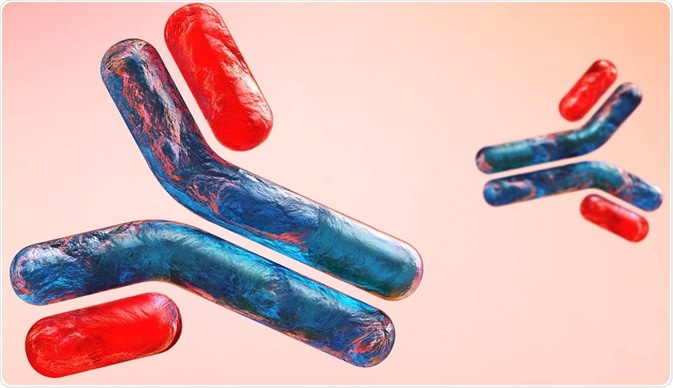Polyclonal antibodies (pAbs) are a complex mixture of several antibodies that are usually produced by different B-cell clones of an animal. These antibodies recognize and bind to many different epitopes of a single antigen and hence can form lattices with the antigens.

ustas7777777 | Shutterstock
How are polyclonal antibodies generated?
Antigen preparation
The quality and quantity of antigen used directly affects the immune response. Even small amounts of impurities will lead to antibodies reacting more to the impurity than to the desired antigen. Too little or too much antigen may cause sensitization, suppression, or other unwarranted immunomodulatory effects. Thus, the purification of the antigen is a crucial process to achieve increased antibody specificity.
The antigen should be prepared under sterile conditions to make sure it is endotoxin free. The quantity of the antigen is dependent on several factors such as properties of the particular antigen, the animal species chosen, injection route, frequency of injection, and the purity level of the antigen.
Animal species selection
The factors that influence the choice of animal species are amount of pAb required, the phylogenetic relationship between the animal and antigen, the age of the animal, the ease of obtaining blood samples, and the application in which the pAb is used.
Commonly used animal species in the laboratory are rabbits, rats, mice, guinea pigs, hamsters, goats, chicken, and sheep. Rabbits are preferred due to their size and relatively long life span. However, in order to produce larger quantities of pAbs, farm animals such as goats, sheep, and horses are used.
Immunization protocol
The immunization protocol differs for different animal species. Adjuvants are compounds used as a form of stimulus in cases where the induced immune response would otherwise be inadequate. The most commonly used adjuvant for production of pAbs is the Freund’s complete adjuvant (FCA).
FCA induces high antibody titers to most types of antigens. However, care should be taken that FCA is not over administered. Use of FCA should be limited to a single time as FCA can cause severe tissue injury.
The smallest volume of antigen capable of inducing an effective immune response is injected into the animal. However, the injection route depends on the nature of the antigen as well as the animal being used. The antigen can be injected as a single volume or as several low volumes at different sites.
Booster injections are provided if the antibody titer concentration has reached a plateau or is declining. Such injections do not always require an adjuvant and very small quantities of the antigen are sufficient to improve the antibody concentration. A maximum of three booster injections is recommended.
Post-immunization observation
Animals are monitored daily to evaluate the side effects of immunization and blood is withdrawn at regular intervals. Serum from the animals is analyzed to monitor the antibody responses and to extract the antibodies when sufficient quantity is produced.
Advantages of polyclonal antibodies
This is a relatively inexpensive process and it can be used to isolate large quantities of an antibody in a single extraction. PAbs are a heterogeneous mix of antibodies that can bind to wide range of antigenic epitopes. Hence, small change in the epitopes of an antigen is less likely to affect pAbs. These antibodies are very stable across a wide range of salt concentrations and pH values.
Disadvantages of polyclonal antibodies
The affinity of pAbs to antigens may change over time thereby leading to a lot of variability between batches. Moreover, the amount of pAbs produced is limited by the size and lifespan of the animal. The purity and concentration levels of a specific antibody are lower in pAbs than that in monoclonal antibodies.
How are polyclonal antibodies used?
pAbs have wide range of applications, including diagnostic testing as well as qualitative and quantitative biological analyses. For example, pAbs are used in immunofluorescence and immunohistochemical techniques such as sandwich ELISA to detect tumor markers and other proteins of interest.
pAbs are also used for mediation or modulation purposes such as in immunotherapy, active signaling, or for neutralizing activities. An example of this is the use of pAbs in the treatment of digoxin Immune Fab in fatal digoxin toxicity.
pAbs such as Rho (D) immune globulin is injected into mothers with Rhesus-negative blood group to prevent hemolytic disease in a newborn. Rho (D) is produced from a pool of human plasma collected from Rhesus-negative donors who have antibodies for the D antigen (present on red blood cells).
pAbs also find applications in histopathological analyses that employ immunoperoxide staining. Apart from these applications, pAbs are used in immunoaffinity purification for purification or enrichment of antigens.
Recombinant pAbs are used in cancer therapy due to their ability to multi-target tumor cells compared to monoclonal antibodies. Although monoclonal antibodies are widely used in cancer therapy, relapse is common due to the emergence of tumor cells that are resistant to the antibody. By using pAbs, diverse recombinant antibodies can be developed that cross-react with different types of cancers.
The way forward shows recombinant pAbs being used to minimize unnecessary polyreactivity as seen when traditional pAbs are used. Use of pAbs in different assays not only generates high throughput but may also be used to develop specific antibodies for human gene products that are also renewable.
Sources
[Further reading: antibodies, antibody